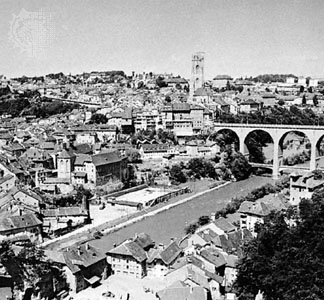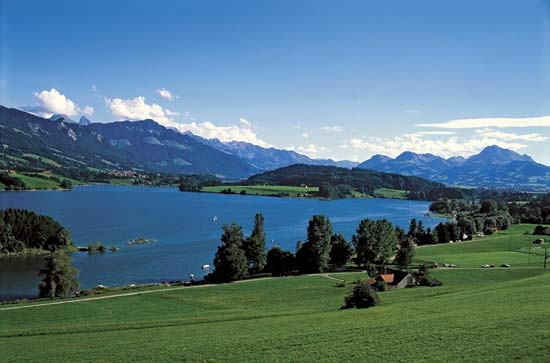Fribourg
Switzerland
German Freiburg
 capital of Fribourg canton, Switzerland. It is located on a loop in the Sarine (Saane) River southwest of Bern. Founded in 1157 by Berthold IV, duke of Zähringen, to control a ford across the river, it passed to the sons of Rudolf of Habsburg in 1277. The Habsburgs abandoned it in 1452; it then accepted the suzerainty of the dukes of Savoy. Fribourg assisted the Swiss in defeating Charles the Bold of Burgundy at Grandson and Morat (now Murten) in 1476 and was admitted to full membership in the Swiss Confederation in 1481. Occupied by the French in 1798, Fribourg became part of the Helvetic Republic and then one of the cantons of the Swiss Confederation as reconstituted by Napoleon's Act of Mediation in 1803.
capital of Fribourg canton, Switzerland. It is located on a loop in the Sarine (Saane) River southwest of Bern. Founded in 1157 by Berthold IV, duke of Zähringen, to control a ford across the river, it passed to the sons of Rudolf of Habsburg in 1277. The Habsburgs abandoned it in 1452; it then accepted the suzerainty of the dukes of Savoy. Fribourg assisted the Swiss in defeating Charles the Bold of Burgundy at Grandson and Morat (now Murten) in 1476 and was admitted to full membership in the Swiss Confederation in 1481. Occupied by the French in 1798, Fribourg became part of the Helvetic Republic and then one of the cantons of the Swiss Confederation as reconstituted by Napoleon's Act of Mediation in 1803.The oldest part of the city (the Bourg) is high above the river bank; the Neuveville, Auge, and Planche (Matte) quarters form the lower part (Basseville). West of the Bourg and still higher are the modern Places and Pérolles quarters. The old quarters retain much of their medieval appearance, characterized by Gothic-fronted houses and the remains of towers and gateways with 13th- to 17th-century ramparts, which originally surrounded the city. Medieval buildings include St. Nicholas Cathedral (13th–15th century) with a famous organ built by Aloys Mooser; the Franciscan church (Église des Cordeliers 【1281; altered 1748】) with a 15th-century reredos; the former Augustinian Church of St. Maurice (1255) with a baroque reredos; and numerous chapels and former convents and monasteries. The town hall dates from 1506–22 with a tower of 1642. Modern architecture includes the university buildings (1941) and the Church of Christ the King (1954). The Sarine River is spanned by several bridges, notably the seven-arched Pont de Zähringen. The seat of the bishopric of Lausanne–Geneva–Fribourg and of a Roman Catholic state university (founded 1889), Fribourg is the centre of Swiss Catholicism. It possesses numerous works of art, mainly preserved in its churches and in the Musée d'Art et d'Histoire.
Situated on the main railway from Lausanne to Bern and a junction of lines to Murten and Payerne, the city is also a centre for bus and postal road services. There are breweries, a foundry, and factories that manufacture chocolate, machinery, and precision instruments.. The population is primarily French speaking. Pop. (2007 est.) 33,418.
canton, Switzerland
German Freiburg
 canton, western Switzerland, bounded by Lake Neuchâtel and the cantons of Vaud on the west and south and Bern on the east, with enclaves within Vaud. It lies in an elevated plain (Swiss Plateau) and rises from flat land in the west through a hilly region up to the PreAlps in the south and east. The highest summits are to the south in La Gruyère district and include the Vanil Noir (7,836 feet 【2,389 metres】). The canton is bisected by the Sarine River (Saane), which flows from south to north (to join the Aare), and by its tributaries. On the west, La Broye flows northeast into Lakes Morat (Murtensee) and Neuchâtel, and, in the southwest, La Veveyse flows south to Lake Geneva (Lac Léman).
canton, western Switzerland, bounded by Lake Neuchâtel and the cantons of Vaud on the west and south and Bern on the east, with enclaves within Vaud. It lies in an elevated plain (Swiss Plateau) and rises from flat land in the west through a hilly region up to the PreAlps in the south and east. The highest summits are to the south in La Gruyère district and include the Vanil Noir (7,836 feet 【2,389 metres】). The canton is bisected by the Sarine River (Saane), which flows from south to north (to join the Aare), and by its tributaries. On the west, La Broye flows northeast into Lakes Morat (Murtensee) and Neuchâtel, and, in the southwest, La Veveyse flows south to Lake Geneva (Lac Léman).Traces of prehistoric settlements have been found on the shores of Lakes Neuchâtel and Morat. The canton, made up of districts acquired by its capital, the city of Fribourg, reached its present extent with the inclusion of the town of Morat (now Murten) in 1803. It joined the Sonderbund (separatist league of Catholic cantons) in 1846 but surrendered to the federal army in 1847. Predominantly Roman Catholic, it has numerous monasteries and convents.
The canton is predominantly rural. Cattle breeding and dairying (including the processing of milk and cheese, notably in La Gruyère district) are important. Market gardening, cereals, tobacco, and fruit prosper in the fertile north and on hillsides in the centre of the canton. Light industries, including food processing, and the manufacture of machinery, metal products, and precision instruments, are largely concentrated in Fribourg city, Düdingen, and Murten and the timber industry in La Gruyère. Power plants in the Sarine district generate electricity for home use and for export. Tourism is most developed in the mountain and lake regions and in Fribourg. The canton is served by the main railway line from Lausanne to Bern, with several branch lines.
Situated on the Swiss linguistic frontier, Fribourg's population is two-thirds French speaking (west) and one-third German speaking (east). Area 645 square miles (1,671 square km). Pop. (2007 est.) 258,252.
- College of Charleston
- College of New Jersey
- College of the Holy Cross
- College of William and Mary
- College Park
- College Station
- collegiality
- collegia pietatis
- Colleoni, Bartolomeo
- Colleton
- Collett, Camilla
- Colley Cibber
- colliding-beam storage ring
- collie
- Collier, Arthur
- Collier, Jeremy
- Collier's Encyclopedia
- colligative property
- collimator
- Colling, Robert; and Colling, Charles
- Collings, Jesse
- Collingwood, Cuthbert Collingwood, 1st Baron
- Collingwood, R G
- Collins, Anthony
- Collins, Edward Knight